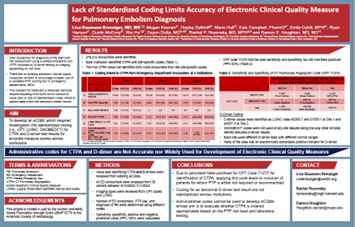Hematology Quality Measures
Timely and Equitable Pain Management for Sickle Cell Disease in the Emergency Department
In partnership with a panel of clinical and patient experts, including emergency physicians, and the Health Services Advisory Group (HSAG), ASH has developed two facility-level electronic clinical quality measures (eCQMs) addressing timely and equitable pain management in the emergency department for individuals living with sickle cell disease:
- Median Time to Pain Medication for Patients with a Diagnosis of Sickle Cell Disease (SCD) with Vaso-Occlusive Episode (VOE):
Median time (in minutes) from Emergency Department (ED) arrival to initial administration of pain medication for all patients, regardless of age, with a principal encounter diagnosis of SCD with VOE
- Difference in Median Times to Pain Medication Between Patients with a Diagnosis of Sickle Cell Disease (SCD) with Vaso-Occlusive Episode (VOE) and Renal Colic:
Difference in median times from ED arrival to initial administration of pain medication between adult patients with a principal diagnosis of SCD with VOE and adult patients with a principal diagnosis of renal colic.
Improving Diagnosis of VTE in the Emergency Department
In partnership with a panel of clinical and patient experts, including emergency physicians, and the Health Services Advisory Group (HSAG), ASH has developed measures that aim to improve the diagnosis of venous thromboembolism (VTE) using Clinical Pretest Probability Tools. This effort was supported in part with funding from the Gordon and Betty Moore Foundation:
Previously Developed Measures
-
MYELODYSPLASTIC SYNDROMES AND ACUTE LEUKEMIAS MEASURES - HEMATOLOGY MEASURE #1: MYELODYSPLASTIC SYNDROME (MDS) AND ACUTE LEUKEMIAS: BASELINE CYTOGENETIC TESTING PERFORMED ON BONE MARROW
-
MYELODYSPLASTIC SYNDROMES MEASURE - HEMATOLOGY MEASURE #2: MYELODYSPLASTIC SYNDROME (MDS): DOCUMENTATION OF IRON STORES IN PATIENTS RECEIVING ERYTHROPOIETIN THERAPY
-
MULTIPLE MYELOMA MEASURE - HEMATOLOGY MEASURE #3: MULTIPLE MYELOMA: TREATMENT WITH BISPHOSPHONATES
-
CHRONIC LYMPHOCYTIC LEUKEMIA MEASURE - HEMATOLOGY MEASURE #4: CHRONIC LYMPHOCYTIC LEUKEMIA (CLL): BASELINE FLOW CYTOMETRY
Quality Measure Reporting
Quality measures are essential tools that quantify performance in the healthcare system and drive quality improvement. If you are a clinician or health care leader needing to report on quality measures, here’s how to get started:
1. Understand the Value of Quality Measures
Quality measures help track and improve care delivery, patient outcomes, and system efficiency. Reporting these measures is often required by payers, including Medicare, and can impact reimbursement. The Centers for Medicare & Medicaid Services (CMS) Quality Payment Program (QPP) establishes a pathway for CMS to provide payment for high-value and high-quality, patient-centered care.
2. Know Your Reporting Pathways
Under the CMS QPP, there are five participation options- or levels at which data can be collected and submitted- individual, group, virtual group, subgroup, or Alternative Payment Model (APM) Entity.
The QPP has two main payment tracks:
- Merit-Based Incentive Payment System (MIPS)- a performance-based payment adjustment system by which payment is based on the selected and reported measures and improvement activities
- Traditional MIPS- the original reporting option in which payment is calculated with quality, improvement activities, promoting interoperability, and cost
- MIPS Value Pathways (MVPs)- payment is calculated based on a subset of measures and activities for a specialty or a specific clinical condition
- Advanced Alternative Payment Models (APMs)- a payment approach with incentives focused on high-quality and cost-efficient care for a specific clinical condition, care episode, or population.
3. Find the Right Measures for Your Practice
Selecting the right measures is important to drive quality improvement and ensure appropriate reimbursement, enabling physicians to deliver high-quality care. Search for current, approved quality measures, and identify which measures are most relevant to your practice with the CMS Inventory Tool.
4. Get Support and Stay Connected
- CMS QPP Support: CMS offers technical assistance and additional information for all reporting tracks. To learn more, visit the QPP Resources Library.
- ASH Resources: ASH provides a variety of quality improvement resources, including guidelines, pocket guides, etc. to support quality improvement activities.


